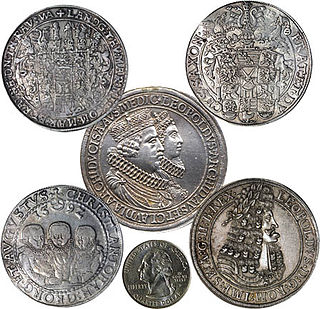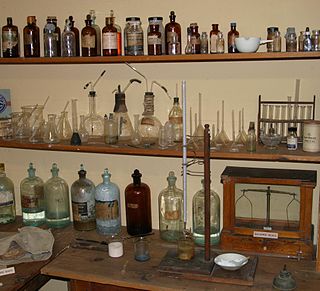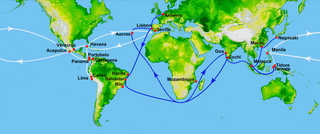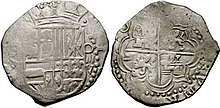
A coin is a small object, usually round and flat, used primarily as a medium of exchange or legal tender. They are standardized in weight, and produced in large quantities at a mint in order to facilitate trade. They are most often issued by a government. Coins often have images, numerals, or text on them. The faces of coins or medals are sometimes called the obverse and the reverse, referring to the front and back sides, respectively. The obverse of a coin is commonly called heads, because it often depicts the head of a prominent person, and the reverse is known as tails.

A thaler or taler is one of the large silver coins minted in the states and territories of the Holy Roman Empire and the Habsburg monarchy during the Early Modern period. A thaler size silver coin has a diameter of about 40 mm and a weight of about 25 to 30 grams. The word is shortened from Joachimsthaler, the original thaler coin minted in Joachimsthal, Bohemia, from 1520.

Precious metals are rare, naturally occurring metallic chemical elements of high economic value. Precious metals, particularly the noble metals, are more corrosion resistant and less chemically reactive than most elements. They are usually ductile and have a high lustre. Historically, precious metals were important as currency but are now regarded mainly as investment and industrial raw materials. Gold, silver, platinum, and palladium each have an ISO 4217 currency code.

The Coinage Act of 1873 or Mint Act of 1873 was a general revision of laws relating to the Mint of the United States. By ending the right of holders of silver bullion to have it coined into standard silver dollars, while allowing holders of gold to continue to have their bullion made into money, the act created a gold standard by default. It also authorized a Trade dollar, with limited legal tender, intended for export, mainly to Asia, and abolished three small-denomination coins. The act led to controversial results and was denounced by critics as the "Crime of '73".

The akçe or akça refers to a silver coin which was the chief monetary unit of the Ottoman Empire. The word itself evolved from the word "silver or silver money", this word is derived from the Turkish ak ("white") and the diminutive suffix -ça. Three akçes were equal to one para. One-hundred and twenty akçes equalled one kuruş. Later after 1687 the kuruş became the main unit of account, replacing the akçe. In 1843, the silver kuruş was joined by the gold lira in a bimetallic system. Its weight fluctuated, one source estimates it is between 1.15 and 1.18 grams. The name akçe originally referred to a silver coin but later the meaning changed and it became a synonym for money.
Bullionism is an economic theory that defines wealth by the amount of precious metals owned. Bullionism is an early or primitive form of mercantilism. It was derived, during the 16th century, from the observation that the Kingdom of England, because of its large trade surplus, possessed large amounts of gold and silver—bullion—despite the fact that there was not any mining of precious metals in England.

The ducat coin was used as a trade coin in Europe from the later Middle Ages to the 19th century. Its most familiar version, the gold ducat or sequin containing around 3.5 grams of 98.6% fine gold, originated in Venice in 1284 and gained wide international acceptance over the centuries. Similarly named silver ducatons also existed. The gold ducat circulated along with the Florentine florin and preceded both the modern British pound sterling and the United States dollar.

The Burji Mamluks or Circassian Mamluks, sometimes referred to as the Burji dynasty, were the rulers of the Mamluk Sultanate of Egypt from 1382 until 1517. As with the preceding Bahri Mamluks, the members of the Burji Mamluk ruling class were purchased as slaves (mamluks) and manumitted, with the most powerful among them taking the role of sultan in Cairo. During this period, the ruling Mamluks were generally of Circassian origin, drawn from the Christian population of the northern Caucasus. The name Burji, meaning 'of the tower', refers to the traditional residence of these Mamluks in the barracks of the Citadel of Cairo.

The Seated Liberty dollar was a dollar coin struck by the United States Mint from 1840 to 1873 and designed by its chief engraver, Christian Gobrecht. It was the last silver coin of that denomination to be struck before passage of the Coinage Act of 1873, which temporarily ended production of the silver dollar for American commerce. The coin's obverse is based on that of the Gobrecht dollar, which had been minted experimentally from 1836 to 1839. However, the soaring eagle used on the reverse of the Gobrecht dollar was not used; instead, the United States Mint (Mint) used a heraldic eagle, based on a design by late Mint Chief Engraver John Reich first utilized on coins in 1807.

The Perth Mint is Australia's official bullion mint and wholly owned by the Government of Western Australia. Established on 20 June 1899, two years before Australia's Federation in 1901, the Perth Mint was the last of three Australian colonial branches of the United Kingdom's Royal Mint intended to refine gold from the gold rushes and to mint gold sovereigns and half-sovereigns for the British Empire. Along with the Royal Australian Mint, which produces coins of the Australian dollar for circulation, the Perth Mint is the older of Australia's two mints issuing coins that are legal tender.
The history of money is the development over time of systems for the exchange, storage, and measurement of wealth. Money is a means of fulfilling these functions indirectly and in general rather than directly, as with barter.

Silver coins are one of the oldest mass-produced form of coinage. Silver has been used as a coinage metal since the times of the Greeks; their silver drachmas were popular trade coins. The ancient Persians used silver coins between 612–330 BC. Before 1797, British pennies were made of silver.

Silver may be used as an investment like other precious metals. It has been regarded as a form of money and store of value for more than 4,000 years, although it lost its role as legal tender in developed countries when the use of the silver standard came to an end in 1935. Some countries mint bullion and collector coins, however, such as the American Silver Eagle with nominal face values. In 2009, the main demand for silver was for industrial applications (40%), jewellery, bullion coins, and exchange-traded products. In 2011, the global silver reserves amounted to 530,000 tonnes.

The United States trade dollar was a dollar coin minted by the United States Mint to compete with other large silver trade coins that were already popular in East Asia. The idea first came about in the 1860s, when the price of silver began to decline due to increased mining in the western United States. A bill providing in part for the issuance of the trade dollar was eventually put before Congress, where it was approved, and signed into law as the Coinage Act of 1873. The act made trade dollars legal tender up to five dollars. A number of designs were considered for the trade dollar, and an obverse and reverse created by William Barber were selected.

Siderokausia, in Ottoman Turkish rendered as ﺳﻴﺪر َﻩ ﻗﺴﯽ Sidrekapsï, was a silver and gold mine active in the Byzantine and Ottoman periods, located in the northeastern Chalkidiki peninsula in northern Greece. The settlements of the region are known to this day as Mademochoria. In the Ottoman period, a coin mint was attached to the mine.

A metallurgical assay is a compositional analysis of an ore, metal, or alloy, usually performed in order to test for purity or quality.

The Ottoman–Mamluk War of 1516–1517 was the second major conflict between the Egypt-based Mamluk Sultanate and the Ottoman Empire, which led to the fall of the Mamluk Sultanate and the incorporation of the Levant, Egypt, and the Hejaz as provinces of the Ottoman Empire. The war transformed the Ottoman Empire from a realm at the margins of the Islamic world, mainly located in Anatolia and the Balkans, to a huge empire encompassing much of the traditional lands of Islam, including the cities of Mecca, Cairo, Damascus, and Aleppo. Despite this expansion, the seat of the empire's political power remained in Constantinople.

Silver Dragon coins, also sometimes known as Dragon dollars, are silver coins issued by China, Japan and later Korea for general circulation in their own countries. Featuring a dragon on the obverse of Japanese and Korean issues and on the reverse of Chinese issues, all were inspired by the silver Spanish dollar which following its introduction into the region in the 16th Century had set the standard for a de facto common currency for trade in the Far East, this specification being a weight of 27.22 grams and a fineness of .900; the coin thus contained 24.5 g of silver.
While the Vikings are perhaps best known for accumulating wealth by plunder, tribute, and conquest, they were also skilled and successful traders. The Vikings developed several trading centres both in Scandinavia and abroad as well as a series of long-distance trading routes during the Viking Age. Viking trading centres and trade routes would bring tremendous wealth and plenty of exotic goods such as Arab coins, Chinese Silks, and Indian Gems. Vikings also established a "bullion economy" in which weighed silver, and to a lesser extent gold, was used as a means of exchange. Evidence for the centrality of trade and economy can be found in the criminal archaeological record through evidence of theft, counterfeit coins, and smuggling. The Viking economy and trade network also effectively helped rebuild the European economy after the fall of the Roman Empire

The global silver trade between the Americas, Europe, and China from the sixteenth to nineteenth centuries was a spillover of the Columbian exchange which had a profound effect on the world economy. Many scholars consider the silver trade to mark the beginning of a genuinely global economy, with one historian noting that silver "went round the world and made the world go round". Although global, much of that silver ended up in the hands of the Chinese, as they accepted it as a form of currency. In addition to the global economic changes the silver trade engendered, it also put into motion a wide array of political transformations in the early modern era. "New World mines", concluded several prominent historians, "supported the Spanish empire", acting as a linchpin of the Spanish economy.


















